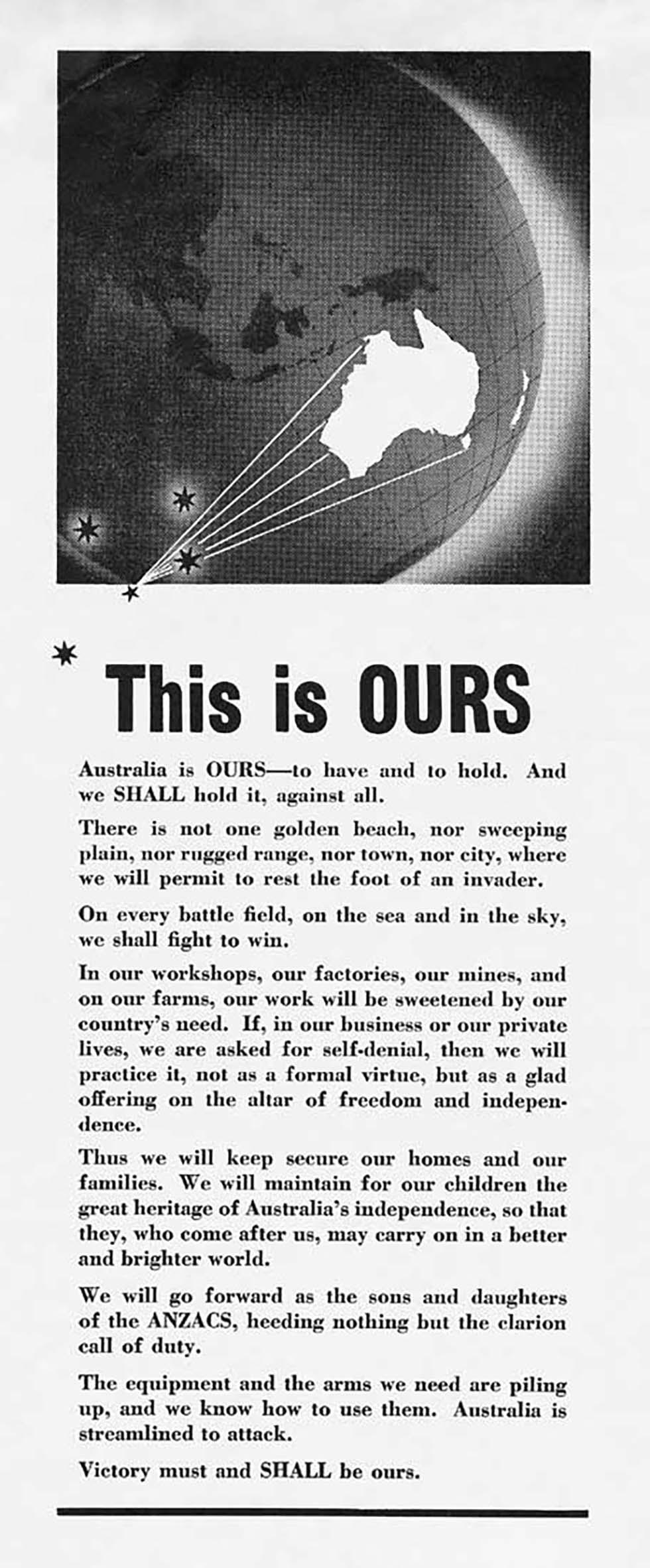


Transcript
[A black and white image of the globe. Most of it is in shadow, while Australia and New Zealand are white, with five white lines drawn from points on Australia’s coast to a depiction of the Southern Cross in the bottom left corner of the image.]
[Heading:] This is OURS
Australia is OURS – to have and to hold. And we SHALL hold it, against all.
There is not one golden beach, nor sweeping plain, nor rugged range, nor town, nor city, where we will permit to rest the foot of an invader.
On every battle field, on the sea and in the sky, we shall fight to win.
In our workshops, our factories, our mines, and on our farms, our work will be sweetened by our country's need. If, in our business or our private lives, we are asked for self-denial, then we will practice it, not as a formal virtue, but as a glad offering on the altar of freedom and independence.
Thus we will keep secure our homes and our families. We will maintain for our children the great heritage of Australia's independence, so that they, who come after us, may carry on in a better and brighter world.
We will go forward as the sons and daughters of the ANZACS, heeding nothing but the clarion call of duty.
The equipment and the arms we need are piling up, and we know how to use them. Australia is streamlined to attack.
Victory must and SHALL be ours.
About this record
This is a black-and-white poster showing a map of the world on which Australia is highlighted and linked to the five stars of the Southern Cross. The poster is titled 'This is OURS', and its emotive text urges Australians to fight to win on the battlefield and at home.
Educational value
- Is an example of a poster being used to deliver war messages from the Australian Government to its citizens during the Second World War (1939-45) – in 1939 Australia entered the war declaring war on Germany, and then in 1941 declared war on Japan.
- Demonstrates the climate of fear that existed in Australia during the war – the 'foot of an invader' is a reference to the threat of Japanese invasion, as Japan had plans to conquer the whole Pacific region, including Australia.
- Reveals the Australian Government's commitment to keeping Japanese forces out of Australia – the Curtin government rejected 'the Brisbane line', a plan put forward in February 1942 by the Australian military command to surrender parts of northern Australia if necessary in order to defend the area south of Brisbane; the plan was inadvertently revealed to the public in 1943.
- Promotes the values of freedom, independence, courage and duty.
- Uses the Southern Cross as a symbol for Australia – the constellation of the Southern Cross, one of the symbols used on Australia's national flag, is generally only visible in the southern hemisphere and is made up of five stars.
- Shows two of the Southern Cross stars outside the box in which the world map has been drawn – this extends the graphic design into the text below, linking the image with the text, and also turns the bottom star into an asterisk, which highlights the message, 'This is OURS'.
- Uses darkness and light in the graphic design to draw the reader's eyes to the map of Australia and to link it to the Southern Cross – the rest of the world (with the notable exception of New Zealand) is in darkness.
- Illustrates the ties between Australia and New Zealand by the representation of both countries in white on the map, while the rest of the world is dark, and in references in the text to the Australian and New Zealand Army Corps (ANZAC) – in World War I, the Australian and New Zealand troops fought together and the ANZAC legend became a source of shared national pride.
- Uses rhetoric to convince the reader – rhetoric is the art of effective and persuasive speaking; for example the opening line 'Australia is OURS – to have and to hold' uses imagery related to marriage to refer to Australians' allegiance to their nation.
- Is an example of the work of the Commonwealth Advertising Division, set up in 1941 within the Department of Information – this poster was aimed at reinforcing the government's commitment to keeping Australia free from Japanese attack.
Acknowledgments
Learning resource text © Education Services Australia Limited and the National Archives of Australia 2010.
Need help with your research?
Learn how to interpret primary sources, use our collection and more.

